1978 Argentine Grand Prix race report
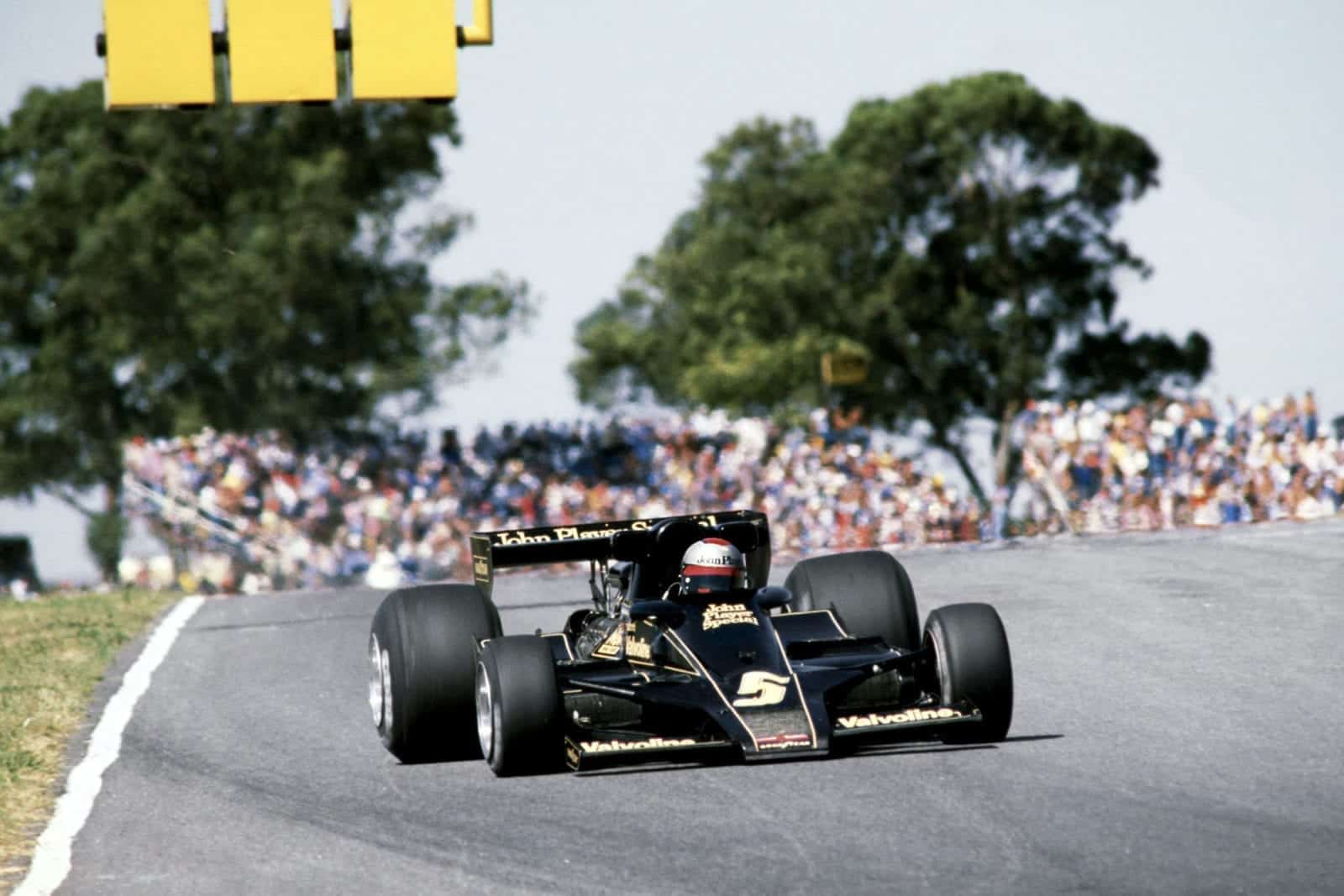
Lotus' Mario Andretti got '78 off to a strong start with a win
Motorsport Images
Andretti and Lotus all the way
Buenos Aires, January 15th
With the Grand Prix season stretching from January to October, it is not unusual for the first race of the year to be like the last one of the previous year, especially as regards the cars, but this year the Argentine entry was full of interest. Mostly it was a matter of drivers among the top echelon changing teams, but there were revised cars and even brand new ones in the paddock as the transport aircraft disgorged their loads during the days before the race. Little Bernie Ecclestone and the Formula One Constructors’ Association had been playing the numbers game, so that the Brabham-Alfa Romeos, now sponsored by Parmalat foods in place of Martini drinks, annexed numbers 1 and 2. This by reason of World Champion for 1977 Niki Lauda leaving the Ferrari team and joining Brabham, taking his number with him. The McLaren pair were relegated to numbers 7 and 8 and March Engineering had done a demon deal with Gunther Schmidt of the ATS Wheel concern in Germany, whereby Robin Herd redesigned their Penske cars so that they became March-ATS, and took the March numbers 9 and 10. The amiable Emerson Fittipaldi was given encouragement by moving him up from 28 to number 14, and Hector Rebaque, who had bought the first Lotus 78, was given number 25, the old Hesketh number. Among the driver changes the most notable after Lauda’s move to Brabham was Peterson’s move from Tyrrell to Lotus, with young Didier Pironi moving up the ELF-inspired ladder from Formula Two to Formula One and into the Tyrrell team. Another interesting French driver, who made a noticeable impression last year, was Patrick Tambay, who has joined the McLaren team at the expense of Jochen Mass. The German became number one in the new March-ATS set-up, along with Jean-Pierre Jarier. The Don Nichols Shadow team was all new, with Stuck and Regazzoni in the cars, the swarthy Swiss leaving the Ensign team without any prior warning. This left Nunn in a quandary, and for the early races this year he has done a deal with Danny Ongais and Lamberto Leoni, but the future looks a bit gloomy for Ensign. In the Surtees team Rupert Keegan was driving the car sponsored by Durex last year and driven by just about everyone, while at the end of the list the new Theodore (Ralt) was driven by young Eddie Cheever, the Formula Two runner who lives in Rome but is actually American.
With the Argentinian Autodrome available for testing before official practice began there was plenty of activity during the week and by Friday an overall atmosphere had developed. The Grand Prix world has largely forgotten what a “tyre war” was all about. Firestone pulled out at the end of 1974 and, for their last couple of years, didn’t really supply many teams of great consequence. True, they had Hesketh and Watson’s private Brabham, but Goodyear settled in a spell of domination once Firestone finally departed. With that spell of domination came the praiseworthy attitude of trying, at least, to bring some semblance of “standardisation” to the tyre front. Fair do’s for all was the motto.
All that was changed in Buenos Aires. Michelin have signed with Ferrari and that meant war, all out war. Against the Maranello line-up Goodyear mustered the best it could offer for the best teams in the business. Competition is said to improve the breed, but one could sense plenty of jittery feelings in the Goodyear-shod teams before official practice began on Friday. Hunt’s fastest practice time from 1977 had taken quite a battering at the hands of Reutemann’s Michelin-shod Ferrari during testing the week before the 1978 Argentinian GP, so Friday’s first official timed practice session was anxiously anticipated. Meanwhile, there were already minor problems cropping up for some people before official practice began. Divina Galica started off on the wrong foot by crashing her Hesketh 308E/4 quite badly, tearing off one corner against the guard rail, but happily emerging unscathed, while Didier Pironi spun his brand new Tyrrell 008 into the catch fencing on the fast esses immediately after the pits. It was repaired successfully in time for Friday and Pironi looked crestfallen, but Ken Tyrrell was kind to him!
Qualifying
Friday morning was cool and windy, untypically Argentinian from most people’s point of view. Right on the dot of 10 a.m. Ecclestone’s two wicked-looking Brabhams led everybody out onto the circuit to commence the first official Formula One practice session of 1978. Unfortunately it proved something of an anti-climax, being stopped twice during the hour and a half. The first time was for stranded cars to be brought in, and the second time for less official reasons; the onset of pouring rain. Most teams scurried for cover in the pits, leaving Reutemann and Villeneuve to splash imperiously round in their Ferraris, shod with Michelin’s wet weather tyres, much to the vocal approval of the small, bedraggled, crowd of spectators.
After that interrupted first practice session, things did not look too good for the majority of the entry. Reutemann’s Ferrari had lapped in a best of 1 min. 47.82 sec., almost a full second quicker than the supremely cool Lauda (1 min. 48.70 sec.) and the delighted Peterson (1 min. 48.87 sec.), who was bubbling over with enthusiasm for the Lotus 78. What’s more, Villeneuve was fourth fastest with 1 min. 48.97 sec. with the second Ferrari, so Michelin had first and fourth, to Goodyear’s second and third, and there was only one Cosworth V8 engine in the first four. Reutemann was quietly satisfied, even though he felt the car was not as good as it had been during testing in Italy. Observers out on the circuit commented on just how stable the Ferraris looked, their tyres hardly leaning at all. They put the power down coming out of the corners and were quick on the straights.
Second man Lauda tugged off his fireproof balaclava and looked thoughtfully down the pit lane towards his old team, then turned away and directed his attention to more immediate matters, that of sifting through the myriad tyre combinations that Goodyear had available to counter the Michelin challenge. Yes, everybody was to be equal as far as tyres were concerned, except that some teams were more equal than others.
Watson was fifth in that first session with 1 min. 49.08 sec., ahead of Hunt’s McLaren M26 (1 min. 49.19 sec.) and Vittorio Brambilla’s Surtees (1 min. 49.91 sec.). Unfortunately, after Brambilla had recorded this very encouraging time, he slid off into the guard rail on the fast right “flick” just before the pits hairpin, when the Hewland gearbox jumped out of gear, damaging the front end of TS19/06 quite comprehensively. He was very apologetic to a noticeably upset John Surtees, when he returned to the pits to continue in the spare car, TS19/02.
Reutemann could not improve on his time during the afternoon session, and Goodyear’s front-line attack stepped up in the shape of Mario Andretti and the Lotus 78. During the morning he had been delayed by a persistent misfire and had been slowest of all. The trouble was traced to a faulty O-ring in the injection system and rectified in time for the afternoon session. During the afternoon Reutemann cut a lap in 1 min. 48.99 sec., but Andretti warmed everybody’s hearts with an excellent 1 min. 48.02 sec., to show that there was still plenty of life left in the Lotus 78. It was the fastest time of the afternoon, but not as fast as Reutemann’s morning time, so 12-cylinders and Michelin tyres were still on pole position.
Watson did a lap in 1 min. 48.42 sec., but Lauda was stranded out on the circuit when the ignition unit failed on his Alfa Romeo engine in BT45/7C and the World Champion briefly took over the spare Brabham for the closing few laps. Peterson did a 1 min. 48.93 sec., almost as quick as his morning best, but the five-speed Lotus/Getrag gearbox he was using on his car was still causing him a lot of selection problems, so it was replaced with a Hewland six-speed unit in time for the Saturday practice. Nevertheless, he was bouncing with joy about the handling of the Lotus 78 and confidently predicting winning races again. Behind the revitalized “SuperSwede”, in sixth place at the end of the day, was young Gilles Villeneuve, seemingly very cautious in his comments about the Ferrari’s behaviour on Michelin tyres, almost as if he could not believe how well things were going. Obviously that bad patch he went through at the end of the 1977 hasn’t daunted him one bit and he was well into the groove in Buenos Aires, driving his Ferrari very positively and forcefully. His best time was min. 48.97 sec. from the morning session, while both the works McLarens were behind the young French-Canadian. Hunt was quite happy with his M26 during the morning, although the onset of rain had ruined his chances of juggling around with the most suitable Goodyear tyres. In the afternoon he bemoaned the fact that he could not manage a quicker time on the softer compounds due to too much understeer. Meanwhile Tambay was getting on with the job well, using M26/1 after his own car broke its engine not long after the morning session had started. He worked his way down to a very respectable 1 min. 49.47 sec. at the wheel of the spare car, while his mechanics installed the team’s Cosworth development DFV into M26/3 for Saturday.
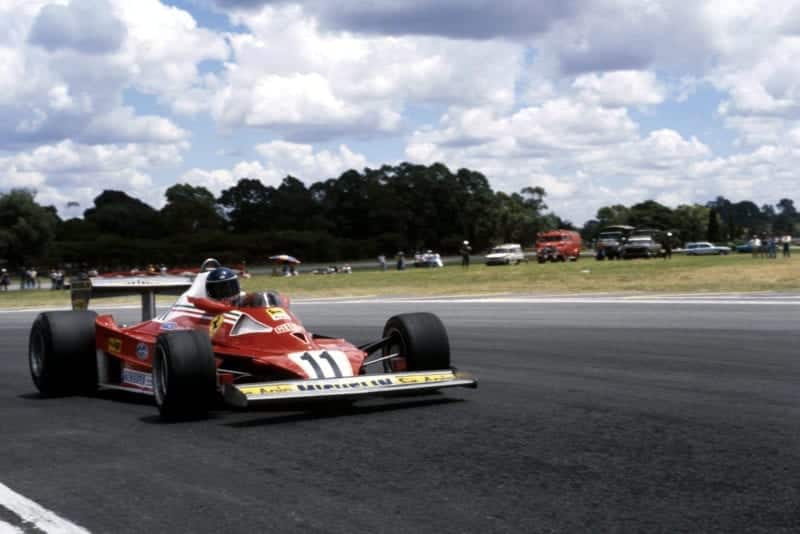
Local hero Carlos Reutemann put his Ferrari 2nd on the grid
Motorsport Images
In the ATS camp there was plenty of optimism on Friday, for the press-on Jarier ended the day with a fine 1 min. 49.77 sec. for ninth quickest overall and was confident he “could beat them all”. Robin Herd, in charge of the Anglo-German operation, grinned indulgently at J.P.’s optimism, but expressed himself quietly satisfied with the first day’s performance. He was comparing the 1978 car’s performance with the 1977 works March cars, which was a bit pointless as the ATS is more a Penske than a 1977 March. Jochen Mass seemed similarly confident although he was cursing right at the end of the afternoon session when a wrong adjustment upset the balance of the car when it was on its best set of tyres. Nevertheless he did manage a 1 min. 50.06 sec. best over the day, slightly slower than Brambilla but considerably less destructive than the Italian, for “Brambles” did it again in the afternoon, hurling the spare Surtees, TS19/02, into the catch fencing at the corner which claimed Hunt’s McLaren during last year’s race. He successfully salvaged the car from the fencing and continued to practise with a substantial dent in the monocoque.
Alan Jones was in trouble with the new Williams FW06, reckoning that its handling was fine but that the oil was overheating and the engine would not rev properly. The overheating problem was quickly cured, but the engine’s reluctance to go much over 10,000 r.p.m. was frustrating. By the end of the day a close examination of the fuel injection system seemed to have pinpointed the trouble, but it returned the following day. The engine was finally changed the night before the race after Jones had qualified 14th. Jacques Laffite was 13th with the Ligier-Matra at the end of Friday, with 1 min. 50.16 sec., while a dejected Jody Scheckter could do no better than 1 min. 50.38 sec. in the new Wolf WR4. The team managed to balance the car a little better as the day wore on, but the Wolf garage was not one of the happiest in which to be by the end of the day.
In the Shadow camp Regazzoni was having his first run at the wheel of the DN8, finding it much heavier to handle than the nimble Ensign he drove last year, but the Swiss managed 1 min. 50.45 sec, Extra oil-coolers were fitted to both Shadows’ flanks for Friday practice, but Stuck wasted a lot of the second session arguing with marshals on the infield loop onto which he had spun after doing a lap in min. 51.16 sec. in DN8/4A. He simply sat in the car waiting for some aid which, in the best manyana tradition, never came. Eventually the lanky German leapt from his car and went striding over to one of the break-down trucks. Berating the driver, Stuck slammed his fist down on the bonnet, which seemed to galvanise everybody into some sort of action. Fortunately the Shadow was moved some way down the grass, because if it hadn’t been moved it would have been “T-boned” by Villeneuve’s spinning Ferrari a short while afterwards.
Emerson Fittipaldi split the two Shadows on Friday with a lap in 1 min. 50.82 sec. in his revised Copersucar-sponsored car, while Keegan’s first outing in a works Surtees was rewarded with a promising 1 min. 51.42 sec., two-tenths faster than the lurid, but amazingly spectacular, Arturo Merzario in his new home-brewed special. Merzario did not seem unduly bothered about the niceties of special tyres or “qualifying rubber”. He just went all-out from start to finish; a rather alarming, if heart-warming sight!
Morris Nunn’s Ensign duo of Ongais (1 min. 51.71 sec.) and Leoni (1 min. 51.01 sec.) followed Merzario, Leoni’s only drama coming when he broke the gear-lever off in his hand! But Nunn was sadly regretting the loss of Regazzoni to a richer team. Then came the always-trying Brett Lunger, followed by the two new Tyrrells. Depailler and Pironi in the four-wheeled Maurice Phillippe designed 008 cars were completely out of the running after a whole host of minor troubles had prevented either of them getting in any serious lappery at all. Depailler’s main problem was with the fuel system and a faulty HT lead, while Pironi’s apparently continual misfire was eventually traced right near the end of the day to a broken sparking-plug lead. It was a truly dismal time for the two Tyrrell drivers, and they only had three other cars below them on the practice lists on Friday night. These were the Formula One novice Hector Rebaque in his newly acquired Lotus 78/1, young Eddie Cheever making his Formula One debut in Teddy Yip’s Theodore TR1, which had broken its engine, and Davina Galica who was quite simply way out of her depth in this company with the spare Hesketh 308E/3.
Saturday’s final hour of practice was to be the big opportunity for the Goodyear runners to come back hard against Reutemann’s Michelin-shod Ferrari, which was holding pole position. With most people scratching to break 1 min. 50 sec. in the final session, it was left to Andretti to rocket round in the only two clear laps he got all afternoon, to snatch pole position from Reutemann with a time of 1 min. 47.75 sec., and this despite a headwind down the back straight that cost anything up to 500 r.p.m. in top gear. Chapman was doubly delighted for not only did Andretti get pole position for the Lotus 78, but Peterson set the second quickest time of the afternoon, and third overall, in spite of a badly blistering rear tyre and some diabolical baulking on the part of the slower runners. His time was 1 min. 48.30 sec. The only other competitor to break 1 min. 49 sec. in the final session of practice was James Hunt, pulling up to sixth place on the grid with 1 min. 48.72 sec., despite acute understeer in the slow corners and awful oversteer in the fast ones; all the wrong way round to the most desirable conditions!
Neither Brabham driver improved on his Friday times and Watson was obliged to use the spare car, BT45/6C, in the final hour, as the engine in his own car turned rough during the morning’s untimed practice. He still held on to fourth place on the grid, alongside Peterson, leaving his team-mate in row three with Hunt; two World Champions side-by-side. Villeneuve and Laflite shared the fourth row, but Depailler made spectacular progress once the new Tyrrell o08 was running properly. He rocketed up to join Tambay’s McLaren M26 on the fifth row with a fine 1 min. 49.69 sec., absolutely delighted with his new mount and in particular with the brakes.
Completing a mid-grid French quartet was Jean-Pierre Jarier in the faster of the two ATS entries (1 min. 49.77 sec.), J.P. not in the least ruffled by the unsettling experience of a front-tyre deflation whilst approaching the long loop at the far end of the circuit in sixth gear. Jones was still in trouble with the fuel system on the Williams, so an engine change was planned before the race, and a dejected Jody Scheckter used his spare car, WR1, in the final hour, after WR4 ran into problems with its gear selectors. He could not make any impression at all on the quickest runners, but managed his best practice time in the last few moments.
The only others to improve in the final hour were Leoni and Pironi, plus Rebaque, who did not qualify anyway, the Mexican joining Cheever and Divina Galica in the non-starters’ department. A spate of engine problems meant that Fittipaldi, Stuck and Laflite all had to use their spare cars during the final hour, while an oil leak on Brambilla’s Surtees ruined another Edenbridge DFV. Lunger tried his spare McLaren, M23/11, when M23/14 broke a bolt in the rear suspension.
Race
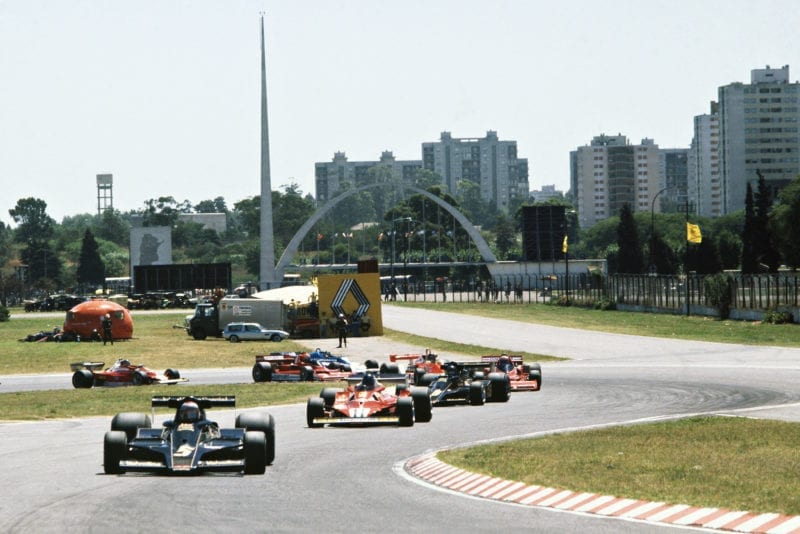
Andretti leads on the first lap
Motorsport Images
The Autodrome was packed from an early hour on Sunday, with delirious chanting front the fans for their beloved “Lole” Reutemann ringing out across the Parc Almirante Brown until the cars finally came out and lined up on the grid with just under half an hour to go before the off. Argentina may well have a very liberal military regime in charge at the moment, but the race at Buenos Aires emphasised that it definitely is a military regime. The practice sessions and the race ran on time, with military precision, but the way in which armed troops kept moving people along, who had a perfect right to be where they were was frightening. The locals are clearly used to this, which makes it appear rather less menacing, but armed troops have no place at a race track.
This was not going to be Reutemann’s day, even though he was starting the race from the front row of the grid, alongside Andretti’s Lotus 78. It was his fourth attempt to win his own Grand Prix and was destined to be just as abortive as his previous three. As the green-light signal flashed Andretti made a superb start, the Lotus surging away into the first right-hander with Peterson trying to make it a Lotus 1-2 by squeezing inside Reutemann’s Ferrari at the first corner, but just failing to get through. Even as they strung out along the back straight it was clear that a Ferrari 312T2, even on Michelin tyres, was no match for an on-form Andretti and the Lotus had already began to edge away from its pursuers.
At the end of the opening lap it was Andretti (Lotus), Reutemann (Ferrari), Peterson (Lotus), Lauda (Brabham), Watson (Brabham), Laffite (Ligier), Hunt (McLaren), Depailler (Tyrrell), Tambay (McLaren), Scheckter (Wolf), Villeneuve (Ferrari), Jones (Williams), Brambilla (Surtees), Regazzoni (Shadow), Jarier (ATS), Stuck (Shadow), Fittipaldi (Fittipaldi), Mass (ATS), Keegan (Surtees), Merzario (Merzario), Pironi (Tyrrell), Lunger (McLaren), Leoni (Ensign) and Ongais (Ensign), who had been left on the line at the start of the race, For a couple of laps Reutemann did his best to keep Andretti in sight, but rather than make any ground on the amazing Lotus he soon found his hands full with a stern Brabham-Alfa attack. First it was Watson who stole the show with an audacious burst pass his World Champion team-mate on the third lap, and then began nibbling away at the Ferrari. By now the enthusiastic crowds had fallen strangely silent and an audible groan could be heard from the main grandstands as Watson slipped his Brabham inside the Ferrari at the end of the tong back straight, mid-way round lap six. It was a fine performance by the Ulsterman, but that was as far as he was destined to go. All there was in front of him was an empty track, for the remarkable Andretti was long gone, being an incredible seven seconds in the lead even by this early stage in the race.
By the end of the seventh lap the order was Andretti, Watson, Reutemann, Peterson, Lauda, the fast-rising Depailler going really well with the new Tyrrell in its debut race, then Laffite and Hunt. There was a slight gap back to Scheckter, Villeneuve and Tambay having their own private dice, Brambilla and Regazzoni (watch it!), Fittipaldi, Mass, Jarier, Jones, Stuck, Pironi and Merzario. The skinny Italian’s new car was smoking badly and sounding rough prior to breaking its differential before to laps were completed. Regazzoni pulled into the pits on lap to to change a blistered front tyre, while Depailler used the Tyrrell’s fine brakes to good effect to slice past Peterson, to take fifth place, the Swede having been passed by Lauda.
Reutemann was obviously in dire trouble with his tyres, with only a dozen laps completed. Depailler was pressing hard and moved through to fourth place on lap 12. Five laps later and “Lole” had dropped another couple of places as Hunt, who’d found a way round Peterson, went past the Ferrari and the Swede followed him through. Now Reutemann was left facing a challenge from Laffite and the Ligier-Matra. For another ten laps the wiry little Frenchman tried everything he knew to find a way past the Argentinian’s Ferrari, but to no avail. Even scrapping away for seventh place Reutemann seemed determined to keep his end up in front of his home crowd. But lap 27 almost spelt the end of his chances.
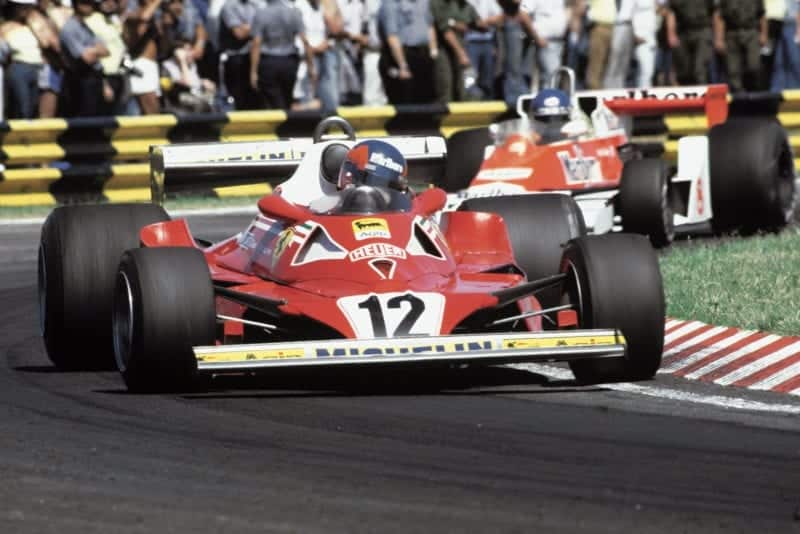
Villeneuve finished 8th
Motorsport Images
Increasingly anxious to find a way round the Ferrari, Laffite went for a gap that momentarily opened as they braked hard for the right-hand hairpin at the end of the back straight. It didn’t quite work and the Ligier went tumbling over the Ferrari’s right rear wheel in the process. Both cars emerged from the corner unscathed, the Ligier now in front, but Reutemann did only one more lap before coming into the pits to change all four tyres on lap 28. He resumed with different compound tyres, in a near-hopeless 15th place and the crowd were heart-broken for their hero.
Out in front Andretti knew nothing of his rival’s tribulations. His progress was startling even to those accustomed to the winning potential of Cohn Chapman’s Supercar. And all this on a circuit with long, long straights. Even at his 1977 peak we had never seen this sort of domination from Andretti; it was all quite stunning and executed in that smooth, unruffled style which the Italian-born American ace has cultivated to go along with the philosophy of the Lotus 78 design.
By lap 30 things were looking good for Mr. Ecclestone’s Parmalat-sponsored Brabham-Alfa Romeo team, for Watson and Lauda were running strongly in second and third places, although the World Champion had to keep a wary eye on his mirrors because Depailler was closing in and spoiling for a fight. Then with 14 laps to go, Lauda suddenly nipped past Watson, not due to finding some extra speed, it was Watson’s wretched luck again. The Ulsterman slowed right up as his Alfa’s water temperature started to rise, and on lap 41, while holding fourth place, he finally retired, a leak in the cooling system having drained away the car’s water. It was yet another entry in the long catalogue of disappointments experienced by Watson over the past two years.
From that point onwards the race ran out uneventfully, with Andretti coming home a brilliant victor, having led from start to finish and running the race at his own pace. The Lotus 78 had been “just perfect” with no problems of any kind. Lauda cemented his new relationship with the Brabham team with a fine second place, albeit at Watson’s expense, but over the last half-dozen laps Depailler had tried everything he could to dislodge the World Champion, but Lauda had everything well under control to keep the upper hand over the tenacious Frenchman right to the end of the race. Nevertheless, ELF Team Tyrrell had every reason to be very pleased with the debut of their new car, especially after such a troubled time in practice.
Fourth place fell to the hard charging Hunt, while Peterson took a lucky fifth three laps from the finish when Laffite’s efforts were cruelly rewarded with a blown-up Matra V12 engine. Sixth place thus went to Patrick Tambay, in his first race for McLaren, having got the better of Villeneuve after their earlier dice. The unhappy Reutemann came back to seventh place after his unfortunate pit stop, vocally willed on his way by his supporters. Villeneuve was eighth, Fittipaldi ninth, and a totally disappointed Scheckter tenth, ahead of the two ATS machines. Concerned that his Shadow might not have enough fuel for the final lap Regazzoni stopped just before the finishing line and drove across once the chequered flag was out. Unfortunately the flag was first waved at Peterson, in error for Andretti, but everybody had been reading their pit signals and went on racing for another lap, so the result was not affected. There were some red faces amongst the race administration over this, for the man who was waving the flag was none other than Juan-Manuel Fangio!
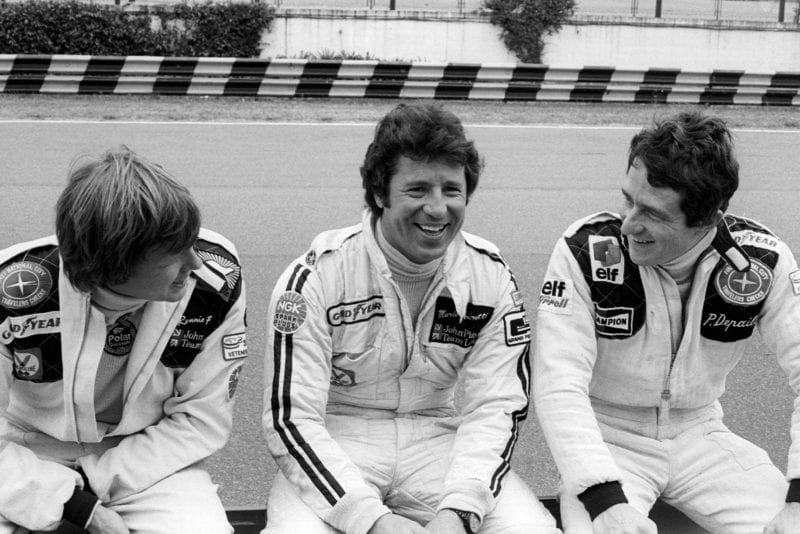
The race win left Andretti with a smile on his face
Motorsport Images
Pironi finished a Grand Prix at his first attempt, while Lunger, Stuck and Brambilla were still running at the end, the Shadow down on power and the Surtees with a seized shock absorber which caused a few harmless trips onto the grass. In terms of mechanical reliability the race had turned out to be far better than most people expected, although both Ensigns succumbed to engine trouble and the Williams eventually stopped with fuel vaporising problems. The Cosworth DFV scored another victory, as did Goodyear tyres, but there would appear to be some writing on the wall, though if truth be told there has been writing on the wall for years now, it’s just a matter of reading it correctly. -A.H.
